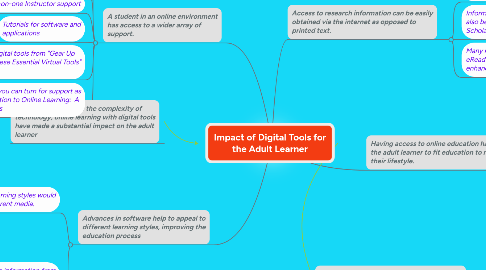
1. Advances in software help to appeal to different learning styles, improving the education process
1.1. Different learning styles would require different media.
1.1.1. Kinesthetic learners learn best by doing. Their preference is for hands-on experiences. (Drago & Wagner, 2004)
1.1.1.1. Language learning software, like Rosetta Stone, require interactive checks to test comprehension
1.1.2. Visual learners like to be provided demonstrations and can learn through descriptions. (Drago & Wagner, 2004)
1.1.2.1. When using programs like Adobe and Acrobat Reader, users have the ability to highlight as well as place notes to emphasize information.
1.1.3. Auditory learners learn by listening. They enjoy aural discussions and dialogues and prefer to work out problems by talking. (Drago & Wagner, 2004)
1.1.3.1. There are Speech-to-Text applications that allow users to highlight information and have it read back to them.
1.2. Reference to Howard Gardner and David Kolb information from "Introduction to Online Learning: A Guide for Students". Multiple different learning styles as well as methods of perceiving that information will handle online settings in a different ways.
2. Introduction: Despite the complexity of technology, online learning with digital tools have made a substantial impact on the adult learner
3. A student in an online environment has access to a wider array of support.
3.1. Forums
3.2. Blogs
3.3. Tech Support
3.4. One-on-one Instructor support
3.5. Tutorials for software and applications
3.6. Cite examples of digital tools from "Gear Up for College With These Essential Virtual Tools" (Witte, 2014)
3.7. Reference where you can turn for support as noted in "Introduction to Online Learning: A Guide for Students
4. Access to research information can be easily obtained via the internet as opposed to printed text.
4.1. By using an online academic institution library, the student has access to eBooks, articles, journals and more.
4.1.1. The world is full of information to be found—however, not all of it is valid, useful, or accurate. (Driscoll & Brizee, 2013)
